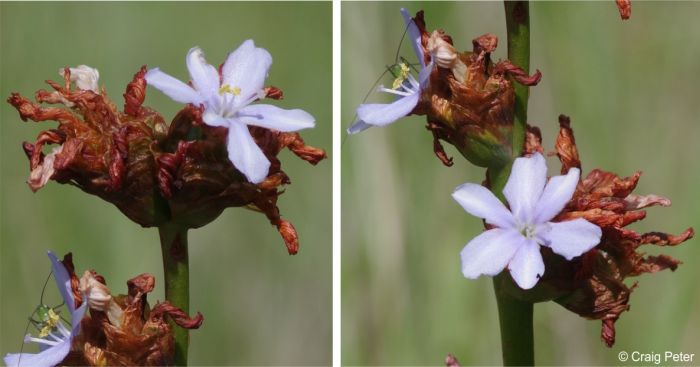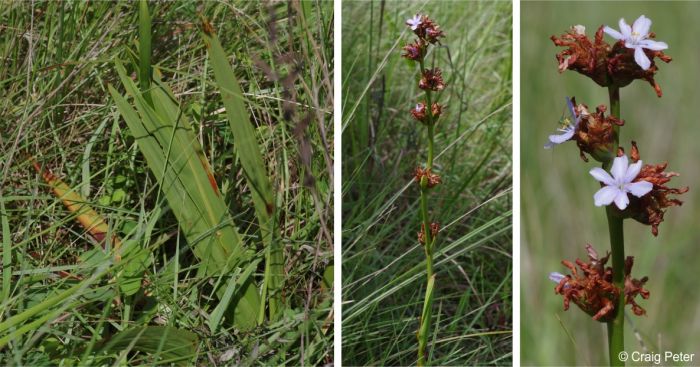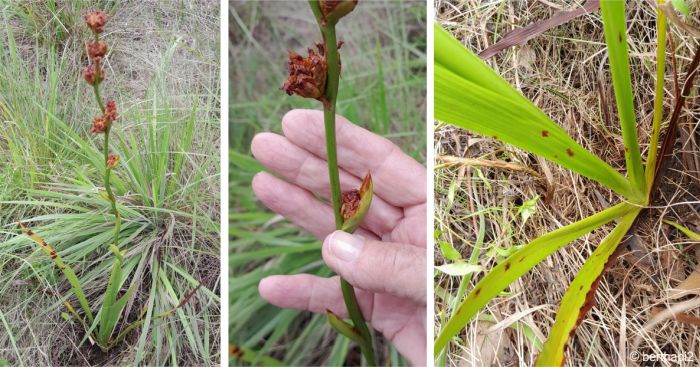Aristea grandis
Aristea grandis Weim.
Family: Iridaceae
Common names: large blue-stars, giant blue-eyed grass (Eng.)
Introduction
A beautiful, robust, grass-like plant with striking deep blue flowers that grow in clusters up tall stems, and broad, pale green leaves. It is a member of the iris family, that consists of approximately 65 genera and 2 300 species.

Description
Description
Aristea grandis is an evergreen, perennial, rhizomatous geophyte. It grows 700 to 950 mm tall. The basal leaves are long and narrow, about half as long as the stem and 10-16 mm wide. The flowers are borne in dense clusters up the tall stems, with up to 6 clusters per stem. The flowers are star-shaped, striking deep blue to violet blue and have contrasting yellow stamens in the centre, adding to their visual appeal. Each cluster consists of up to 16 flowers in a large, leathery, green spathe. Flowering time is in midsummer (December and January). The fruit is a shallowly 3-lobed capsule 7-8 mm long, containing smooth, angular seeds, about 1.5 mm long.

Conservation Status
Status
Aristea grandis is assessed as Critically Endangered (CR) according to the Red List of South African plants, which means that the plant is facing an extremely high risk of extinction. This is a rare species with a natural range less than 10 km² that is known from just two locations. It has lost much of its habitat to urban development and the loss and degradation of its habitat is ongoing.
Distribution and habitat
Distribution description
The native range of Aristea grandis is coastal KwaZulu-Natal in South Africa, from Inanda to the Kloof-Hillcrest area near Durban, which is in the subtropical biome. Its habitat is coastal grassland and it is characterized by seasonal summer rainfall and well-drained soils.
Derivation of name and historical aspects
History
The genus name Aristea is derived from the greek word arista, meaning ‘awn,’ which is a dry, pointed-tipped, bract-like structure such as is found on the type species, Aristea africana. The species name grandis is derived from Latin and means ‘large’ or ‘great’, and most likely refers to the size of the plant. Aristea grandis thus translates roughly into ‘large aristea’, highlighting the quality that characterizes this species.
Aristea belongs in the iris family (Iridaceae), most members of the family are perennial herbs and are distributed worldwide. The family contains about 2 300 species and more than half of them, 1 210 species, occur in southern Africa. The genus Aristea contains about 58 species that occur in sub-Saharan Africa and Madagascar, with 46 species in southern Africa.

Ecology
Ecology
Aristea grandis flowers last for just one day, closing and withering after midday. No nectar is produced and they are pollinated by pollen-collecting female bees. The seeds may be dispersed by wind or water.
Uses
Use
Aristea grandis can be used as an ornamental plant in gardens and for landscaping. A similar and more widespread species, Aristea ecklonii (blue stars), is used in traditional medicine for treating fever, coughs, syphilis and internal sores, and as a protective charm, and it is possible that this species is used similarly.
Growing Aristea grandis
Grow
Aristea grandis can be propagated through seeds or division. Sow seeds in spring or early summer, during the warmer months. Sow them thinly in a well-drained sowing medium, mixing the seeds with fine dry sand before sowing helps to achieve better distribution and prevents damping off. Sift another fine layer of compost or vermiculite over the seeds, place them in a heated propagator and keep moist. Propagation can also be done by division by simply lifting a mature plant and separating the smaller plants from the clump into multiple pieces and re-plant immediately.
Grow this plant in well-composted, well-drained soil and plant in a sunny, well-watered position in a frost-free environment.
References
- berthapi2. 2023-Dec. Observation of Aristea grandis, Hillcrest, KZN. iNaturalist. Online. https://www.inaturalist.org/observations/195651058.
- Goldblatt, P. & Manning, J.C. 2020. Iridaceae of southern Africa. Strelitzia 42. South African National Biodiversity Institute, Pretoria.
- Goldblatt, P. 2013. Aristea (Iridaceae, Aristeoideae), a subgeneric classification. Novon: A Journal for Botanical Nomenclature 22(4):415-417.
- Maroyi, A. 2020. Review of medicinal applications, phytochemistry and pharmacological properties of Aristea ecklonii. Journal of Pharmacy and Nutrition Sciences 10:46-40.
- Mtshali, H. 2021. Aristea grandis Weim. National Assessment: Red List of South African. http://redlist.sanbi.org/species.php?species=1515-23. Accessed on 2024/08/12.
- Peter, C. 2022-Jan. Observation of Aristea grandis, Hillcrest, KZN. iNaturalist. Online. https://www.inaturalist.org/observations/105197761.
- Raimondo, D., Von Staden, L., Foden, W., Victor, J.E., Helme, N.A., Turner, R.C., Kamundi, D.A. & Manyama, P.A. (eds) 2009. Red list of South African plants. Strelitzia 25. South African National Biodiversity Institute, Pretoria.
- Vincent, L.P.S. 1985. A partial revision of the genus Aristea (Iridaceae) in South Africa, Swaziland, Lesotho, Transkei and Ciskei. South African Journal of Botany 51(4):209-252.
Credits
Ramaboea Sefularo and Ntombizodwa Nkuna, National Zoological Gardens
and Alice Notten, Kirstenbosch National Botanical Garden
September 2024
Acknowledgements: the authors thank Craig Peter and berthapi2 for making their pictures available via iNaturalist.
Plant Attributes:
Plant Type: Bulb
SA Distribution: KwaZulu-Natal
Soil type: Sandy, Loam
Flowering season: Late Summer
PH: Acid, Neutral
Flower colour: Blue
Aspect: Full Sun
Gardening skill: Average
Special Features:
Horticultural zones







Rate this article
Article well written and informative
Rate this plant
Is this an interesting plant?
Login to add your Comment
Back to topNot registered yet? Click here to register.